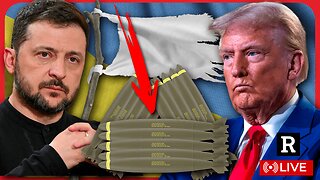Premium Only Content

🐁 How to Revive Mammal From Hypoglycemic Shock/Coma
I have used this same overall technique many times as a wildlife rehabilitator to revive nearly dead and comatose small mammals (and some birds), especially orphaned baby cottontails, squirrels, and rats, but the same should apply to most mammals you find in this condition if the condition is caused by starvation or hypoglycemic shock, or perhaps septic shock. The basics consist of immediate stabilization of body temperature, and IM injections of B complex (approx 0.5ml/kg), dextrose for injection (I use approx 100mg/kg), calcium gluconate (100mg/kg), and it's absolutely critical to use a phosphorus/phosphate containing solution, such as CMPK/Oral Cal MPK, available from Tractor Supply. Though not intended for injection, if the animal is too weak to take PO fluids without aspiration, the CMPK will need to be injected. At this stage, the risk of death from depleted phosphate in starvation outweighs the risk of injecting a non-sterile oral solution. For an animal this small, I use no more than about 0.05-0.1ml of CMPK initially, and then after the animal begins to recover and can take PO fluids, I give small amounts in water through a syringe until fully recovered, then cease. Do not overdo CMPK. It also contains potassium, which can cause cardiac failure in excessive amounts. Only the amount needed to achieve a positive result within 10-20 min. Do not be afraid to use larger amounts of B complex if first or second results not positive. It is rapidly absorbed and utilized, especially by small mammals with high metabolism, and little to no toxic side effects of overdose of B vitamins.
As SOON as the animal can get on its feet, start putting an easy to consume and digest source of food under its nose. A piece of apple, blueberry, milk replacer formula, critical care, yogurt, apple sauce, fruit and veggie based baby food (if not a milk drinking neonate), etc. This emergency resuscitation protocol using dextrose and Vit B boost will wear off QUICKLY in a small animal that has high metabolism, so you have to immediately begin back-stopping this with real easy to convert digestible food as soon as the animal can take food on its own. Do not FORCE whole food into its mouth, and do not use solid and slow to digest foods, with too much protein, like pellets. Use something that's going to be soft and easy on the stomach at first, until they're looking normal again.
*If the condition is likely caused by septic shock, then add dexamethasone or some other corticosteroid to this basic protocol. After the animal begins showing improvement, then address abx protocol.
Find me on MeWe:
https://mewe.com/p/reptilerescuerehabilitation
Please give, and help provide medical care and sanctuary for wildlife and many exotic animals who have no one else to help them. This rescue is funded entirely on donations. There are no government grants. No corporate sponsors. Just myself, and less than a dozen regular donors who believe that these animals need help. Your support helps keep the doors open and one more animal to be saved. 🐤 🐍 🐢 🦎 🦆 🐇 🐁 🐟 🐖 🕊 You can help by making a donation today.
PayPal: wfreptilerescue@gmail.com
Donate without a PayPal account at this checkout:
https://www.paypal.com/cgi-bin/webscr?cmd=_donations&business=WFReptileRescue@gmail.com
#cutefunnyanimals #babyanimal #animalrescue #wildliferescue #rabbit #rat #squirrel #cottontail #wildliferehabilitation
-
 10:20
10:20
Reptile Rescue
1 year ago $0.02 earned𝓑𝓮𝓵𝓵𝓪'𝓼 𝓢𝓪𝓭 𝓢𝓽𝓸𝓻𝔂 - 𝓦𝓲𝓬𝓱𝓲𝓽𝓪 𝓕𝓪𝓵𝓵𝓼 𝓡𝓮𝓹𝓽𝓲𝓵𝓮 𝓡𝓮𝓼𝓬𝓾𝓮
98 -
 1:46
1:46
WMAR
3 years agoOfficers injured in Frederick shooting released from shock trauma
6 -
 4:29
4:29
The Ron Paul Liberty Report
3 years agoFrom the Nixon Shock to Biden-flation
1.19K11 -
 1:13:13
1:13:13
Michael Franzese
3 hours agoMegyn Kelly’s UNFILTERED Take on The Ukraine War, Trump & Modern Masculinity
23.8K13 -
 1:43:21
1:43:21
Redacted News
4 hours agoBREAKING! UKRAINE AGREES TO CEASEFIRE WITH RUSSIA... BUT THERE'S A BIG CATCH | Redacted News
119K219 -
 58:17
58:17
Candace Show Podcast
5 hours agoShould We Feel Bad For Blake Lively? | Candace Ep 157
67.3K131 -
 3:06:52
3:06:52
The Nerd Realm
6 hours ago $10.28 earnedHollow Knight Voidheart Edition #19 | Nerd Realm Playthrough
46K4 -
 1:17:27
1:17:27
Awaken With JP
8 hours agoThe Current Thing: Tesla Protesting - LIES Ep 82
86.9K38 -
 1:07:08
1:07:08
Sean Unpaved
5 hours agoNFL Free Agency Rolls On! MLB Spring Training Heats Up along with 3x World Series Champ Dave Stewart
51.1K3 -
 2:10:15
2:10:15
Right Side Broadcasting Network
10 hours agoLIVE REPLAY: White House Press Secretary Karoline Leavitt Holds Press Briefing - 3/11/25
141K41